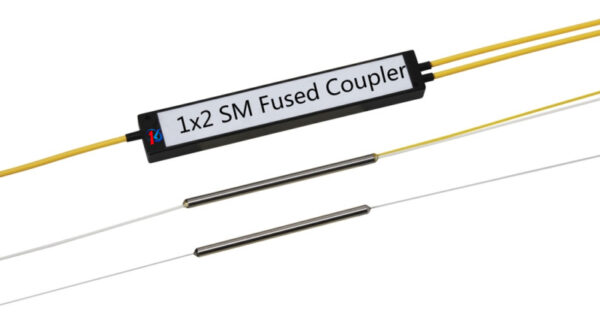Fiber Optic fused Couplers are the key elements in fiber-optic networks for the redistribution of optical signals. Fiber coupler devices are used as small components within various optical modules and systems for long-distance signal transmission, signal amplification, monitoring, and conditioning. They are also widely used in passive optical access networks.
A fiber optic coupler or optical fused coupler is an optical device that is used to distribute the optical signal from one fiber into two or more fibers and vice versa. A basic optical coupler has N input ports ranging from 1 to 64 and M output ports ranging from 1 to 64 for signal distribution. The number of ports on both sides depends on the optical application and network
Manufacturing of Fused Optical Couplers
The manufacturing process of optical fused couplers is known as the Fused Biconical Taper (FBT) process. A fused coupler has two parallel optical fibers that are fused together to bring their core very close to from a Coupling Region. The length of this region determines the coupling ratio from one fiber optic to the other. A light signal is launched into the input port to carefully monitor the output power from each output port during the manufacturing process. After achieving the desired coupling ratio, the manufacturing process is stopped for the particular fused optical coupler.
Types of Fiber Optic Couplers
Fiber optic couplers can be categorized based on various parameters to achieve desired functionality for a specific optical application in a fiber network.
Optical Couplers Classified by Shape
- Y Coupler
It Resembles the English letter Y, and also known as optical tap coupler. A single input signal is distributed into two output signals using a Y coupler with any coupling ratio from 0.1% to 50% for specific applications. The power distributions ratio is precisely controlled for an optical network.
- X Coupler (2×2)
It usually resembles the function of an optical signal splitter or combiner. It is used to combines or divides optical power from the input ports to the output ports.
- Star Coupler
Star coupler combines several input and output ports for desired signal distribution. The number of input and output ports can be in any combination for optical power distribution using start couplers. However, the coupling rations remain equal among all the output ports.
- Tree Coupler
It is also a multiport coupler, buy only at the output side. It is used to optical power from one input fiber to N numbers of output fibers in an optical fiber network. It is also used reversely to combine multiple optical signals to one output fiber.
Optical Couplers Classified by Wavelength
Optical couplers are usually designed for single wavelength, dual-wavelength or wideband transmissions. You can select optical fiber couplers based on bandwidth, regardless of the type of ports used. As the name suggests, single-window couplers incorporate a single wavelength, dual-wavelength couplers work with two wavelengths at the same time, and wideband couplers are designed for a wider range of wavelengths for optical signal transmission.
At DK Photonics, we sell a wide range of optical fused couplers for a variety of applications in different settings. All the products are tested for high stability and reliability in your fiber network. We also help our clients with customized solutions to meet their specific requirements with high-quality optical passive components. Contact us to discuss your custom needs and requirements.
